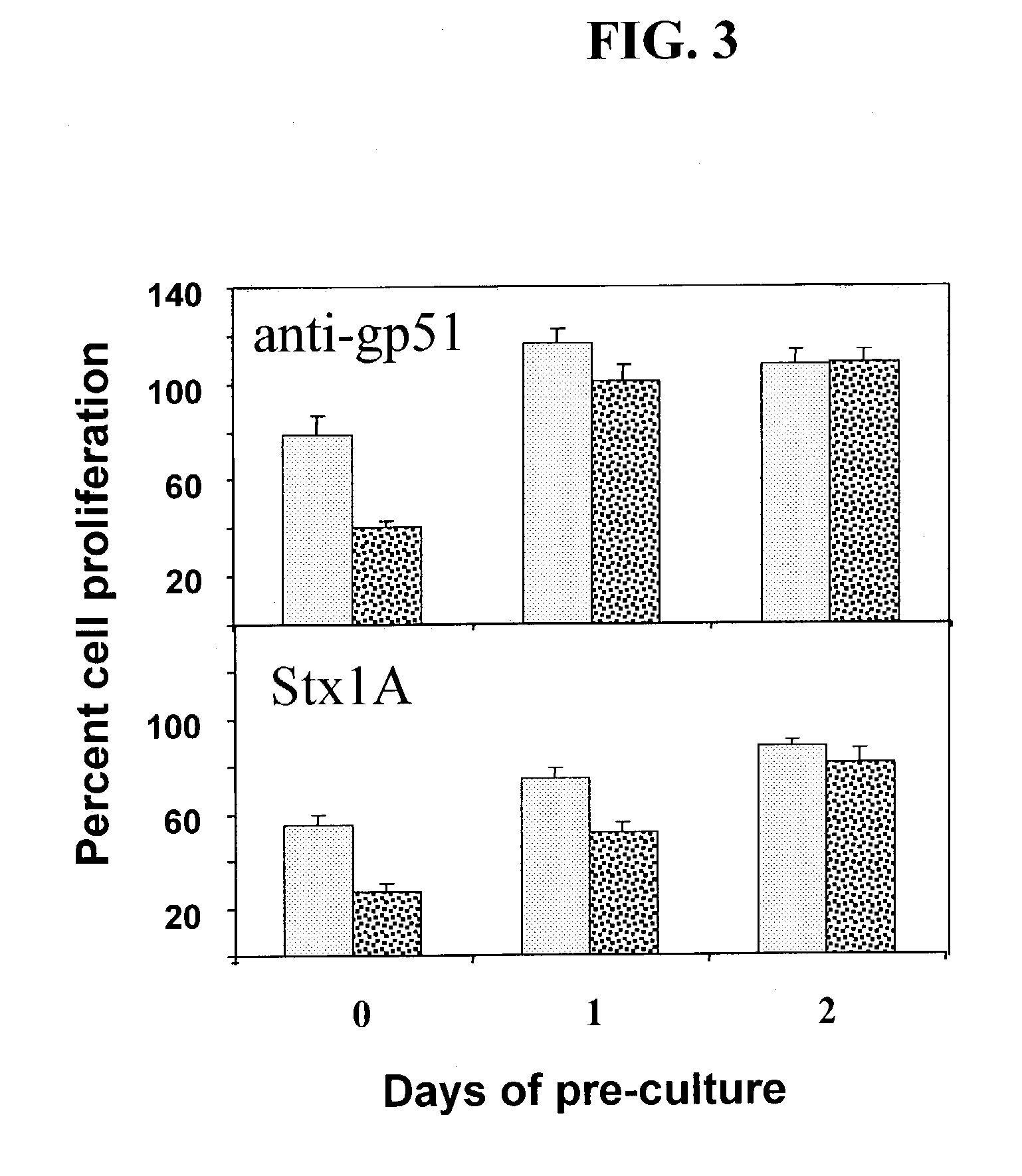Antiviral activity of Shiga toxin
a technology of shiga toxin and antiviral activity, which is applied in the field of antiviral activity of shiga toxin, can solve the problems of insufficient effectiveness of cattle or sheep vaccination, high cost of cattle production, and strong risk factor for lymphoma development,
- Summary
- Abstract
- Description
- Claims
- Application Information
AI Technical Summary
Benefits of technology
Problems solved by technology
Method used
Image
Examples
example 1
Suppression of Bovine Leukemia Virus Spontaneous Lymphocyte Proliferation by Stx1
[0081]In this example, the suppression of BLV-related spontaneous lymphocyte proliferation by administering purified Stx1 holotoxin and Stx1 subunit A is described.
[0082]Materials and Methods. Freisian-Holstein cows from the University of Idaho dairy were used as blood donors. Cows were identified as BLV-positive by high titers of anti-BLV antibody. Five persistently lymphocytotic (PL) cows were identified by elevated numbers and percentages of B cells (three standard deviations above normal levels) in peripheral circulation and used as BLV-positive donors. Cows with no detectable anti-BLV antibodies were used as BLV-negative donors.
[0083]Blood was collected by jugular venipuncture into acid-citrate-dextrose (ACD) (one part to four parts whole blood). PBMC were purified by density gradient centrifugation using Accu-Paque (Accurate Chemical and Scientific Corp., Westbury, N.Y.) (1.086 g / ml) as previously...
example 2
Suppression of Bovine Leukemia Virus-Related Cell Proliferation by Administering to Cows a Probiotic E. coli Expressing Stx1A
[0107]In this example, the suppression of BLV-related cell proliferation by administering a representative probiotic E. coli expressing Stx1A is described.
[0108]Materials and Methods. The techniques of amplification of genetic sequences with the polymerase chain reaction, cutting and splicing DNA into plasmids, transformation of bacteria with plasmids, and assays for antibody binding are all well known biotechnology methods and detailed descriptions of these methods can be found in a number of texts, for example Sambrook et al. (1989) Molecular Cloning-A Laboratory Manual, Cold Spring Harbor Laboratory, Cold Spring Harbor, N.Y.
[0109]Commonly used procaryotic control sequences, which are defined herein to include transcription initiation, optionally operator, and ribosome binding site sequences, can include commonly used promoters such as the beta-lactamase (pe...
example 3
Suppression of Bovine Leukemia Virus-Related Cell Proliferation by Administering to Cows a Transgenic Plants Expressing Stx1A
[0120]In this example, the suppression of BLV-related cell proliferation by administering a representative transgenic plant expressing Stx1A is described.
[0121]Materials and Methods. The techniques of amplification of genetic sequences with the polymerase chain reaction, cutting and splicing DNA into plasmids, transformation of bacteria with plasmids, and assays for antibody binding are all well known biotechnology methods and detailed descriptions of these methods can be found in a number of texts, for example Sambrook et al. (1989) Molecular Cloning-A Laboratory Manual, Cold Spring Harbor Laboratory, Cold Spring Harbor, N.Y.
[0122]The coding sequence for Stx1A is inserted into the 30B expression vector (Shivprasad et al. (1999) Virology 255:312–23). This tobacco mosaic virus-based expression vector contains a heterologous coat protein subgenomic mRNA promoter...
PUM
| Property | Measurement | Unit |
|---|---|---|
| density | aaaaa | aaaaa |
| pH | aaaaa | aaaaa |
| density | aaaaa | aaaaa |
Abstract
Description
Claims
Application Information
 Login to view more
Login to view more - R&D Engineer
- R&D Manager
- IP Professional
- Industry Leading Data Capabilities
- Powerful AI technology
- Patent DNA Extraction
Browse by: Latest US Patents, China's latest patents, Technical Efficacy Thesaurus, Application Domain, Technology Topic.
© 2024 PatSnap. All rights reserved.Legal|Privacy policy|Modern Slavery Act Transparency Statement|Sitemap



